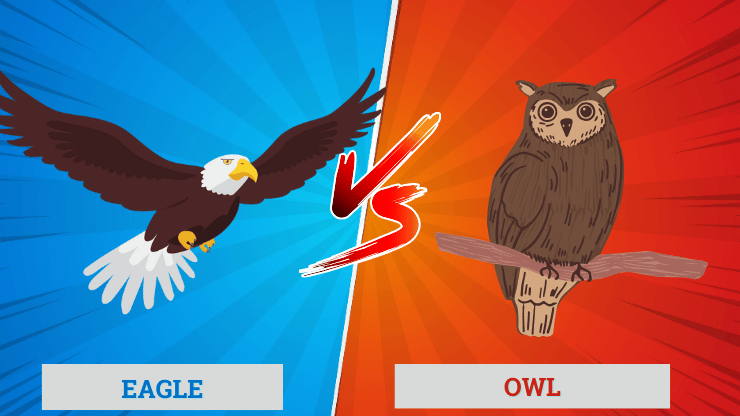Eagles and owls are two of the most captivating birds of prey, both known for their impressive hunting skills and their vital roles in the ecosystem. While they share similarities as powerful predators, they also differ greatly in behavior, physical characteristics, and hunting techniques. In this comparison, we’ll explore the unique traits of each to better understand what makes both eagles and owls extraordinary in their own ways.

Table of Contents
Physical Appearance
Eagles are large, powerful birds with sharp, hooked beaks and strong talons that make them highly effective hunters. They have long, broad wings that allow them to soar effortlessly at great heights. Their eyesight is exceptional several times sharper than a human’s and they can spot prey from well over a mile away under the right conditions.
Owls, on the other hand, typically have a more rounded, compact body with short tails and broad wings designed for silent flight. Their most distinctive feature is their large, forward-facing eyes set within a flat facial disk. This facial disk helps channel sound toward their ears, greatly enhancing their hearing, which is one of their most important tools for finding prey in low-light conditions.
Hunting Styles and Prey
Eagles are diurnal hunters, meaning they are active during the day. They rely heavily on their exceptional eyesight to track prey, which often includes fish, small mammals, and even other birds. Eagles are known for their power and speed, and many species perform high-velocity dives to capture their targets with precision.
Owls, by contrast, are primarily nocturnal hunters, relying on their extraordinary hearing and strong low-light vision to locate prey. Their soft, silent flight enables them to swoop down on targets without being detected. Most owls hunt small mammals, insects, and occasionally other birds, though their exact diet varies widely depending on species and habitat.
Habitat Preferences
Eagles are commonly found near large bodies of water or in open terrain, where they can easily spot prey from above. Many species, such as the Bald Eagle, nest near lakes and rivers, while others thrive in mountainous regions, coastal cliffs, or expansive plains. Different eagle species adapt to a variety of landscapes depending on their prey and nesting needs.
Owls, on the other hand, are often associated with wooded areas and dense forests, where their camouflage and silent flight give them an advantage. However, owl habitats can vary widely, and some species prefer grasslands, deserts, or agricultural areas. The Barn Owl, for example, thrives in open fields and farmlands where small rodents are abundant.
Vocalizations and Communication
Eagles communicate using sharp calls, which can vary from loud, piercing cries to softer whistles depending on the species. These vocalizations help them defend their territory, attract mates, and assert dominance within their range.
Owls are often associated with their classic hoots, but their vocalizations vary widely between species. Their calls are typically used to claim territory, communicate with potential mates, or signal distress. Many owl species can also produce screeches, whistles, hisses, and clicking sounds, giving them one of the most diverse vocal ranges among birds of prey.
Vision and Hearing
Eagles are renowned for their exceptional vision. Their eyesight is several times sharper than that of a human, allowing them to spot prey from impressive distances. Eagles rely primarily on sight to locate and capture their prey during daylight hours.
Owls, in contrast, use a powerful combination of excellent low-light vision and extraordinary hearing. Their large eyes are well adapted to dim environments, while their asymmetrically placed ears allow them to pinpoint the location of sounds with remarkable accuracy—even when visibility is extremely poor. These abilities give owls a tremendous advantage when hunting at night.
Social Behavior
Eagles are often considered more social compared to owls, especially since many species form lifelong pair bonds and share responsibilities when raising their young. Although generally territorial, some eagles such as Bald Eagles may tolerate or even gather with others in areas with abundant food or during migration.
Owls, in contrast, are strongly solitary birds. They prefer to hunt alone and usually defend their territories fiercely. Outside of the breeding season, most owls avoid interaction with others of their species, and even when raising young, they maintain a largely independent, non-social lifestyle.
Cultural Significance
Eagles are widely regarded as symbols of strength, freedom, and power. Many nations, including the United States, feature the eagle as an emblem of national identity and pride. Their commanding presence and soaring flight have long represented heroism, authority, and resilience across many cultures.
Owls, on the other hand, are often associated with wisdom and mystery. In some traditions, they are revered as guardians of the night and symbols of knowledge, while in others, their nocturnal behavior and haunting calls have linked them to omens or superstition. Their cultural symbolism varies greatly around the world, reflecting the complex relationship humans have with these enigmatic birds.
Conclusion
Both eagles and owls are awe-inspiring birds of prey, yet they represent different aspects of the natural world. Eagles dominate the skies during the day with their powerful vision and hunting skills, while owls silently patrol the night, using their acute senses to thrive in darkness.
Their differences in appearance, behavior, and adaptations make them each uniquely equipped to survive in their respective domains, showcasing the incredible diversity of avian life. Whether you’re observing the commanding flight of an eagle or the quiet glide of an owl, both birds remind us of the wonder and beauty of the wild.
Check My other related posts:
Eagle Vs Hawk: Explore The Differences
